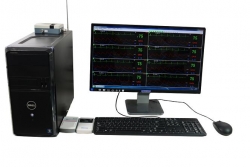Wechat QR code

TEL:400-654-1200

TEL:400-654-1200
Elevated lactic acid and venous blood gas interpretation
A 23-year-old female was admitted to hospital with "bleeding diarrhea for 5 days and vomiting for 3 days with severe abdominal pain". Unable to eat through the mouth, she lost 7 pounds during the course of the illness, and her eyes were sunken. Vital signs: heart rate 144, blood pressure 70/55, breathing 32, no fever. Abdominal CT shows colitis and intestinal obstruction. Bedside venous blood gas: pH 7.19, PvCO2 91mmHg, SvO2 91%, lactic acid 8.0mmol/L. Consider the possibility of sepsis.Meilun
The difference between type A and type B lactic acid in this paper lies in the understanding of the concept of true hypoxia. Lack of oxygen means oxidative phosphorylation and cessation of the tricarboxylic acid cycle. When oxygen in mitochondria cannot act as a terminal electron acceptor, the electron transport chain is interrupted, and H+ in the mitochondrial inner membrane diffuses outward. Pyruvate and lactic acid levels rise and secondary acidosis occurs. This is the biochemical change in true hypoxia, called an elevated type A lactic acid. (see figure 1A)Meilun

In what is referred to clinically as hypoxia, the electron transport chain process is actually still operating, but at a slower rate. At this point, the tricarboxylic acid cycle cannot timely process the large amount of pyruvate produced by the decomposition of sugar. Under certain stress conditions (e.g., sepsis, exercise) or large amounts of catecholamine, pyruvate levels rise and change to lactic acid during H+ neutralization (i.e., glycolysis, which produces 2 H+ and 2 molecules of pyruvate, which converts to lactic acid and neutralizes 2 H+). The tricarboxylic acid cycle runs slowly (without oxygen) and lactic acid levels rise. So this is type B lactic acid.
Elevated type B lactic acid is a common condition in sepsis. There are many factors in the increase of lactic acid under aerobic condition, among which adrenalin acting on muscle fibers is the most common. Epinephrine activates the glycolysis pathway, which elevates lactic acid when the tricarboxylic acid cycle is functioning normally. To carry on the fluid to the sepsis patient, reduces the adrenalin concentration, causes the lactic acid to drop. This was similar to the decrease of heart rate after fluid resuscitation and the differential diagnosis of elevated lactic acid was similar to that of sinus tachycardia.
Tissue oxygen consumption and CO2 formation
Watch out for a drop in the volume of tissue oxygen transport (DO2). However, tissue oxygen consumption (VO2) remains constant until DO2 reaches a critical value. The reason is that tissues take more oxygen from red blood cells. The plateau of the VO2/DO2 curve partly reflects the physiological changes of aerobic respiration, where the continuous oxygen consumption of tissues is constant. Since the oxygen consumption remains constant, the CO2 production also remains constant. The ratio of CO2 production to oxygen consumption (VCO2/VO2) is 0.7-1.0, which is called respiratory entropy (R). Respiratory entropy was mainly affected by carbohydrate intake (figure 2).
These rules must be understood when interpreting a venous report. In the aerobic portion of the curve, SvO2 decreases as the body takes in more oxygen from hemoglobin to maintain oxygen consumption. Since oxygen consumption is constant, CO2 production should remain constant. However, the decrease of blood flow will lead to the increase of CO2 content per unit blood volume, thus leading to the rise of CO2 partial pressure in venous hemorrhage. Normal partial pressure difference of arteriovenous CO2 should be less than 6mmHg.
On the other hand, the respiratory entropy VCO2/VO2 ratio of the plateau part of the curve (i.e. under aerobic conditions) is < 1.0. This was calculated by the Fick equation. The difference of CO2 content between arteries and veins is directly related to the amount of CO2 produced by tissues. Similarly, the difference in oxygen content between arteries and veins is determined by tissue oxygen consumption. Therefore, divide the difference of arteriovenous CO2 content (i.e., VCO2) by the difference of arteriovenous oxygen content (i.e., VO2) to get the value of respiratory entropy, which should be less than 1.0 under aerobic conditions. The lactic acid elevation in this case reflects the above mentioned physiological process of type B lactic acid.
Critical value of oxygen transport (cDO2)
When does tissue oxygen consumption (VO2) begin to decline? Is there actually a lack of oxygen in the tissue? Firstly, due to the decrease of oxygen consumption, the difference of oxygen content between arteries and veins shrinks, and the venous oxygen saturation increases in venous blood gas. Does the amount of CO2 produced in tissues decrease in proportion to the decrease in oxygen consumption? So VCO2 over VO2 stays the same, right? The answer is no, because CO2 production increases in the absence of oxygen. As mentioned above, when the electron transport chain speed slows down, free H+ is generated, and additional CO2 is generated in the buffer process with bicarbonate. Therefore, in the case of hypoxia, venous blood PvCO2 continued to increase, and VCO2/VO2 ratio increased. Recent studies have strongly supported this theory. Mallat et al. used multiple markers to predict VO2/DO2 dependence. VO2/DO2 dependence means that the oxygen delivery of patients falls below cDO2, that is, they are in the descending branch of the vo2-do2 curve (hypoxia part).
VO2 increased by at least 15% in these patients after volume resuscitation. That is to say, only patients with descending ramus will respond to the increase of DO2 with VO2. The use of central venous oxygen saturation (AUC 0.624) and lactic acid (AUC 0.745) could not determine whether the patient was on the descending branch of the vo2-do2 curve. If the critical value of VCO2/VO2 is greater than 1.02, the area under the curve can reach an astonishing 0.965. The low predictive value of lactic acid may reflect the physiological changes of type B lactic acid in sepsis patients. Since there is a good linear relationship between CO2 production and CO2 partial pressure, the clinical value of VCO2 can be simply replaced by the differential value of arteriovenous CO2 partial pressure. The pa-vco2 /VO2 ratio with 1.7mmHg/ml as the cut-off value showed excellent predictive efficiency (AUC 0.962).
Back to the case
Although there is no arterial blood gas to control this case, there are still some traces of venous blood gas to explore. First, the venous oxygen saturation of the patient increased, indicating a decrease in oxygen consumption (VO2). In addition, PvCO2 is extremely high. Although we cannot know the specific partial pressure of arterial blood CO2, the patient is young and has shortness of breath, and PaCO2 should be much lower than 91mmHg. Although it is impossible to calculate the value accurately, the above values indicate that the VCO2/VO2 ratio increases, suggesting that the oxygen transport of patients is lower than that of cDO2, and there is tissue hypoxia. The patient presented with elevated type A lactic acid and should be admitted to ICU.
Finally, it should be noted that venous blood gas analysis only reflects the peripheral tissue metabolism of venipuncture site. In clinical practice, upper arm venous blood is often used, but in Mallat studies, central venous blood is used. If the blood sample of the internal jugular vein is collected, it can also reflect the oxygen condition of the brain. Obviously, the collection site should be taken into account when interpreting venous blood gas reports.